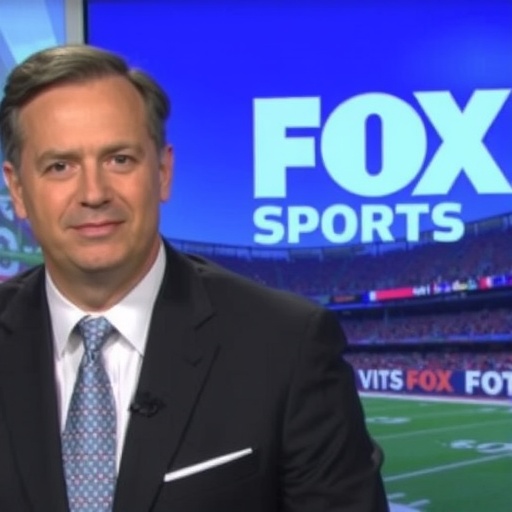Fox Sports CEO Eric Shanks Breaks Silence on NFL’s Early Media Rights Negotiations: What’s Next for Broadcasting Deals
In a surprising yet anticipated twist in the world of sports broadcasting, Fox Sports CEO Eric Shanks has openly addressed the NFL’s potential move toward early negotiations for its lucrative media rights package. Speaking at a recent industry conference, Shanks revealed that this development was far from shocking for the network, signaling a proactive stance amid escalating competition for NFL content. As the current media rights agreements approach their expiration in 2033, the possibility of early talks could reshape the broadcasting landscape, with Fox Sports positioned as a key player hungry to maintain its stronghold.
The NFL’s media rights, valued at over $100 billion in the current cycle, represent the crown jewel of American sports broadcasting. Fox Sports, which has held exclusive rights to Thursday Night Football and a significant share of Sunday afternoon games since 1994, stands to gain or lose immensely from any renegotiation. Shanks’ comments come at a time when streaming giants like Amazon, Netflix, and Apple are circling, ready to disrupt traditional networks’ dominance.
Shanks’ Unfazed Response to NFL’s Negotiation Signals
Eric Shanks, the seasoned leader of Fox Sports, didn’t mince words during his address at the Sports Business Journal’s D.C. Summit. “We’ve been preparing for this moment for years,” Shanks stated, emphasizing that the NFL’s hints at early media rights discussions were “not unexpected news” for the team at Fox. He highlighted the network’s long-standing partnership with the NFL, which has generated billions in revenue and captivated millions of viewers week after week.
Under Shanks’ guidance since 2016, Fox Sports has invested heavily in production quality and digital integration, ensuring that its broadcasting of NFL games remains a premier experience. In 2023 alone, Fox’s NFL coverage drew an average of 17.3 million viewers per regular-season game, according to Nielsen data, underscoring the network’s vital role in the league’s visibility. Shanks pointed out that early negotiations could allow for stability, but he cautioned against undervaluing the contributions of established broadcasters like Fox in an era dominated by tech-driven platforms.
This candid revelation from Shanks adds a layer of intrigue to the ongoing saga. While the NFL has not officially confirmed early talks, Commissioner Roger Goodell has previously alluded to exploring extensions before the 2033 deadline. Shanks’ composure suggests Fox is ready to engage, potentially leveraging its track record to secure favorable terms.
The High-Stakes World of NFL Media Rights Valuation
The NFL‘s media rights deals are the lifeblood of modern sports broadcasting, with the current package—split among CBS, NBC, ESPN, and Fox Sports—totaling $110 billion over 11 years. This unprecedented sum, agreed upon in 2021, marked a 75% increase from the previous cycle, driven by the league’s global appeal and the explosion of streaming options. For Fox Sports, the deal includes $2.025 billion annually for its share, covering Sunday NFC games, the Super Bowl in even-numbered years, and international rights.
Eric Shanks has been vocal about the evolving value of these rights. In an interview snippet shared post-conference, he noted, “The NFL is more than just football; it’s a cultural phenomenon that demands premium broadcasting partners who understand storytelling.” Statistics back this up: The 2023 Super Bowl on Fox averaged 115.1 million viewers, the most-watched telecast in history, generating ad revenue exceeding $500 million. Yet, as rights fees continue to climb—projected to surpass $150 billion in the next cycle—networks like Fox face pressure to innovate.
Competitors are already positioning themselves. Amazon Prime Video, which holds Thursday Night Football rights, paid $1 billion annually in the last deal and is rumored to be eyeing expansion. Disney’s ESPN, facing cord-cutting woes, might bundle more NFL content with its streaming service. Shanks acknowledged these threats, stating that Fox Sports is exploring hybrid models, including enhanced digital rights, to stay competitive in early media rights talks.
- Key Stats on NFL Rights: Current deal: $10 billion/year; Viewer growth: 12% YoY on linear TV; Streaming penetration: 25% of NFL audience in 2023.
- Fox’s Share: 23% of total rights value, focusing on high-engagement games.
- Future Projections: Analysts predict 30-50% fee increases, per PwC’s Global Entertainment & Media Outlook.
Fox Sports’ Storied History with NFL Broadcasting Excellence
Since acquiring the NFC package in 1994 for a then-record $4.4 billion, Fox Sports has transformed NFL broadcasting with innovative graphics, celebrity analysts like Terry Bradshaw and Howie Long, and immersive coverage. Under Eric Shanks, the network has doubled down on this legacy, launching Fox Sports 1 in 2013 and integrating NFL content across platforms. Shanks, a broadcasting veteran with over 30 years in the industry, joined Fox in 2007 and rose to CEO by navigating the shift from cable to cord-cutting.
One standout example is Fox’s handling of the 2022 World Cup qualifiers intertwined with NFL programming, which boosted cross-promotion. Shanks credited the network’s success to its commitment to “fan-first” broadcasting, including features like the “Fox NFL Sunday” pregame show, which consistently ranks as the top-rated sports studio program. In 2023, it averaged 2.8 million viewers, per Sports Media Watch.
However, challenges persist. The rise of direct-to-consumer services has fragmented audiences, with NFL+ streaming league-exclusive games. Shanks addressed this head-on, saying, “We’re not just broadcasters; we’re ecosystem builders.” Fox’s recent acquisition of Tubi for ad-supported streaming positions it to compete in media rights battles, potentially offering NFL content to a broader, younger demographic.
Industry insiders praise Shanks’ strategy. “Eric has kept Fox relevant in an NFL world that’s increasingly digital,” said Bill Carter, a veteran media analyst. This history gives Fox Sports leverage in early negotiations, as the NFL values partners with proven delivery.
Industry Ripples: How Early Talks Could Reshape Broadcasting
The prospect of early NFL media rights negotiations isn’t isolated to Fox Sports; it sends shockwaves across the broadcasting sector. Traditional networks like CBS and NBC, which share Sunday and Sunday Night rights respectively, are reportedly monitoring closely. ESPN’s parent company, Disney, extended its Monday Night Football deal through 2033 but could seek adjustments for streaming rights.
Eric Shanks highlighted the broader implications during his talk: “Early talks ensure the NFL‘s growth without disruption, but they must account for the investments broadcasters have made.” Analysts from Deloitte estimate that premature deals could lock in rates before inflation and viewership spikes, potentially benefiting the league but squeezing margins for partners like Fox.
Streaming behemoths are the wild cards. Netflix’s rumored interest in NFL games, following its WWE deal, could introduce global reach but at a premium cost. Amazon, already entrenched, might push for exclusivity. A PwC report forecasts that by 2028, 40% of sports broadcasting revenue will come from digital platforms, up from 20% today.
- Potential Shifts: Increased streaming bundles, like NFL on Peacock or Paramount+.
- Fox’s Edge: Strong linear viewership (70% of NFL audience) versus pure streamers.
- Risks: Higher rights fees could lead to blackouts or reduced local coverage.
Shanks’ optimism stems from Fox’s adaptability. The network’s recent partnerships, such as with Google for YouTube TV integration, demonstrate a forward-thinking approach to media rights.
Charting the Path Forward: Implications for Fox and the NFL
As Fox Sports and the NFL eye early media rights discussions, the focus shifts to what comes next. Eric Shanks concluded his remarks by urging collaborative planning: “Let’s build a future where broadcasting evolves with the fans, not against them.” For Fox, this means bolstering its digital arm—Fox Sports app downloads surged 35% in 2023—and exploring international expansion, given the NFL’s growing overseas footprint with games in London and Germany.
Looking ahead, negotiations could commence as early as 2025, per league insiders, aiming to extend deals through 2040. This timeline would allow the NFL to capitalize on post-pandemic viewership highs, which hit 93% of U.S. households in 2023. For Fox Sports, success hinges on demonstrating ROI through metrics like engagement rates, where its NFL coverage leads with 45 minutes of average watch time per game.
The broader industry watches intently. If early talks succeed, they could set a precedent for other leagues like the NBA and MLB, stabilizing broadcasting amid economic uncertainties. Shanks’ steady hand positions Fox well, but the outcome will test whether tradition can coexist with innovation in the high-stakes arena of sports media rights. As the 2024 season kicks off, all eyes are on how these conversations unfold, potentially defining the next decade of NFL fandom.










